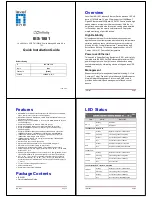
D-Link DES-3326SR Layer 3 Switch
Reverse Path Broadcasting (RPB)
The Reverse Path Broadcasting (RPB) algorithm is an enhancement of the multicast spanning tree algorithm. RPB
constructs a spanning tree for each multicast source. When the router receives a multicast packet, it then checks to determine
if the packet was received on the shortest path back from the router to the source. If the packet was received on the shortest
path back to the source, the packet is forwarded on all links except the link on which the packet was received. If the packet
was not received on the shortest link back to the source, the packet is dropped.
If a link-state routing protocol is in use, RPB on a local router can determine if the path from the source through the local
router to an immediately neighboring router. If it is not, the packet will be dropped at the next router and the packet should
not be forwarded.
If a distance-vector routing protocol is in use, a neighboring router can either advertise its previous hop for the source as part
of its routing update messages. This will ‘poison-reverse’ the route (or have the local router prune the branch from the
multicast source to the neighboring router because the neighboring router has a better route from the source to the next router
or subnetwork).
Since multicast packets are forwarded through the shortest route between source and destination, RPB is fast. A given router
also does not need information about the entire spanning tree, nor does it need a mechanism to stop the forwarding of
packets.
RPB does not use multicast group membership information in its forwarding decisions.
Reverse Path Multicasting (RPM)
Reverse Path Multicasting (RPM) introduces an enhancement to RPB – an explicit method to prune branches of the spanning
tree that have on active multicast group members for the source. RPM constructs a tree that spans only subnetworks with
multicast group member and routers along the shortest path between the source and the destinations.
When a multicast router receives a multicast packet, it is forwarded using the RPB constructed spanning tree. Subsequent
routers in the tree that have no active path to another router are referred to as leaf routers. If the multicast packet if
forwarded to a leaf router that has no active multicast group members for the source, the leaf router will send a prune
message to the previous router. This will remove the leaf router’s branch from the spanning tree, and no more multicast
packets (from that source) will be forwarded to it. Prune messages have a TTL equal to one, so they can be sent only one
hop (one router) back toward the source. If the previous router receives prune messages from all of its branch and leaf
routers, the previous router will then send it’s own prune message back one router toward the multicast source, and the
process will repeat. In this way, multicast group membership information can be used to prune the spanning tree between a
given multicast source and the corresponding multicast group.
Since the membership of any given multicast group can change and the network topology can also change, RPM periodically
removes all of the prune information it has gathered from it’s memory, and the entire process repeats. This gives all
subsequent routers on the network a chance to receive multicast packets from all multicast sources on the network. It also
gives all users a chance to join a given multicast group.
Multicast Routing Protocols
This section contains an overview of two multicast routing protocols – Distance Vector Multicast Routing Protocol
(DVMRP), and Protocol Independent Multicast-Dense Mode
(PIM-DM). The most commonly used routing protocol (not a multicast routing protocol), the Routing Information Protocol,
is discussed in a later section.
Distance Vector Multicast Routing Protocol (DVMRP)
The Distance Vector Multicast Routing Protocol (DVMRP) was derived from the Routing Information Protocol (RIP) with
the introduction of multicast delivery trees constructed from information about the ‘distance’ from the local router back
toward the multicast source. DVMRP uses an RPM algorithm to construct its multicast delivery trees.
The first multicast packet received by a multicast router using DVMRP is flooded to all interfaces except the one on which
the packet was received. Subsequent prune messages are used to prune branches of the delivery tree that are either not on the
205
Содержание DES-3326SR
Страница 240: ......
















































